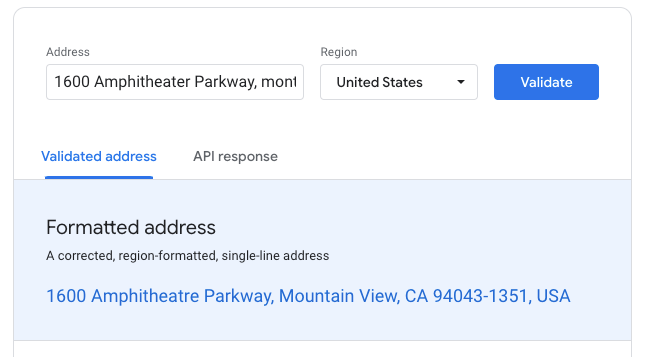簡介
Address Validation API 是一項接受地址的服務。 這項服務會識別並驗證地址元件,這項服務也會將地址標準化以利郵寄,並找出最合適的經緯度座標。(選用) 如果地址位於美國和波多黎各,可以啟用編碼準確度支援系統 (CASS™)。使用 Address Validation API 的原因
使用 Address Validation API,您可以提高送達預測準確度並減少送貨失敗情形,進而提升顧客體驗。方法是找出錯誤地址,並進一步瞭解地址特徵。
如果您不需要驗證個別地址元件,可能更適合使用 Geocoding API。Geocoding API 會將地址轉換為經緯度座標,Address Validation API 會驗證地址的正確性。如需詳細比較,請參閱 Architecture Center 的「使用 Google 地圖平台建構位置驗證功能」。
Address Validation API 的用途
您可以使用 Address Validation API 判斷地址是否為實際地點。如果地址並非指涉實際地點,API 可以找出可能錯誤的元件,供您向顧客顯示並修正。以下是使用 API 的工作流程範例:
顧客輸入地址:下圖顯示基本表單,可讓顧客輸入地址,可能是在結帳流程中。
應用程式將地址傳送至 API:應用程式會將這個地址做為 Address Validation API 的輸入內容。
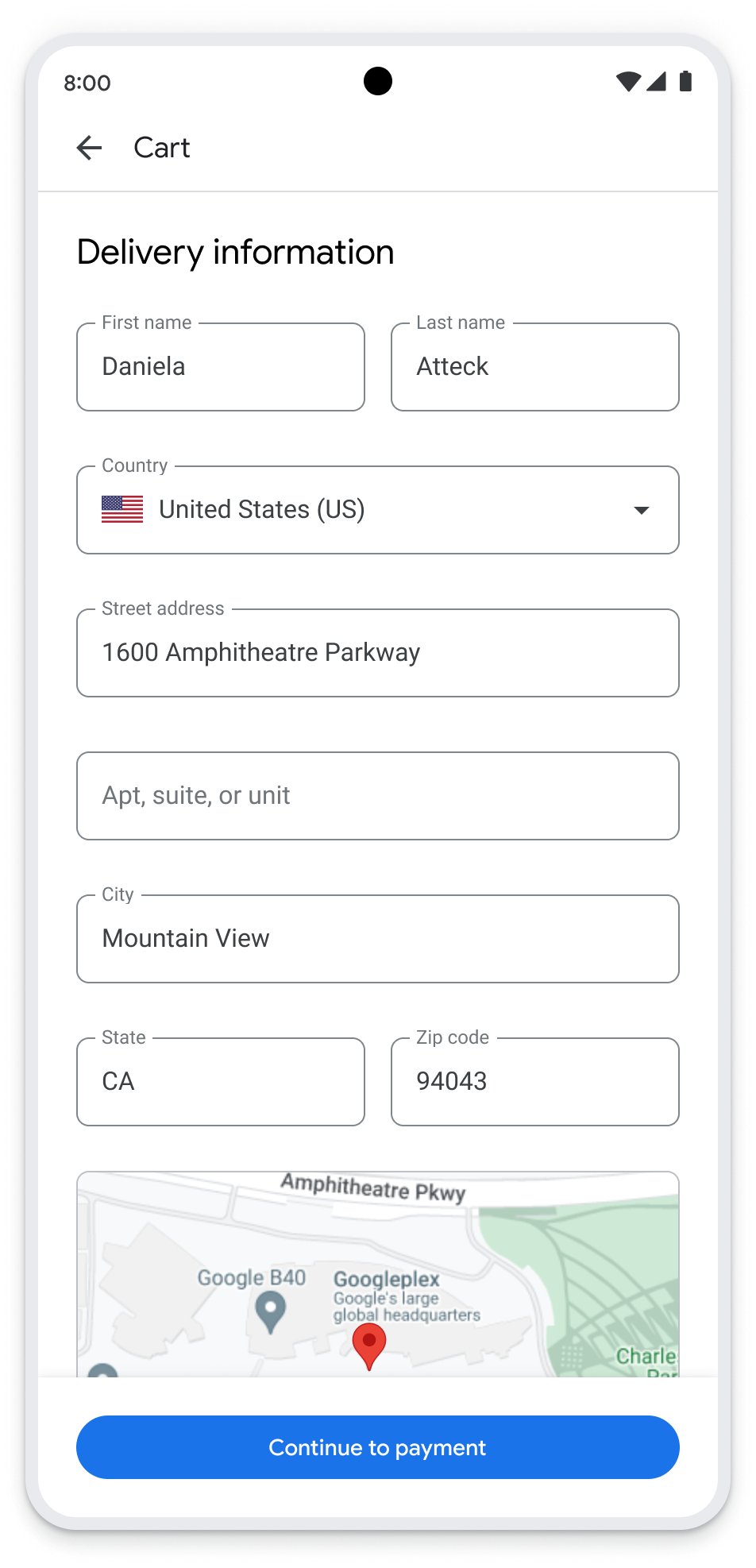
API 驗證並標準化地址:Address Validation API 會在回應中傳回 API 判斷的完整地址,或指出缺少資訊的位置。
顧客確認或修正地址:視 API 傳回的內容而定,您可以向顧客提供下列提示: A. 確認建議地址。B. 提供缺少的資訊。 C. 修正地址。
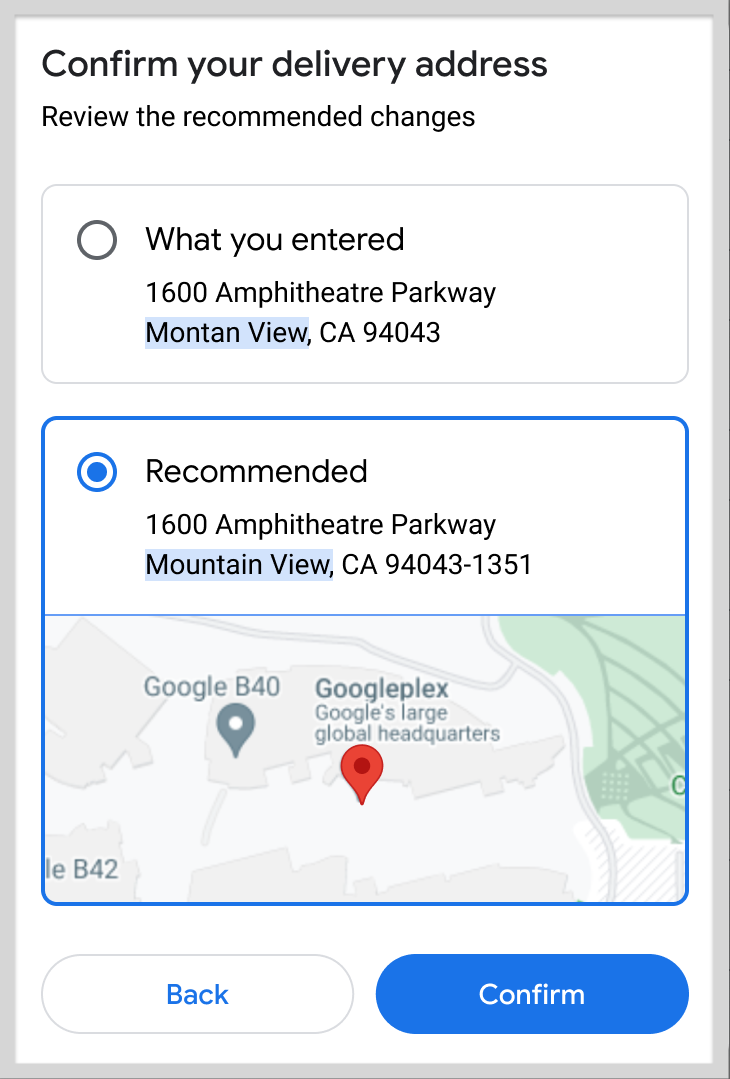
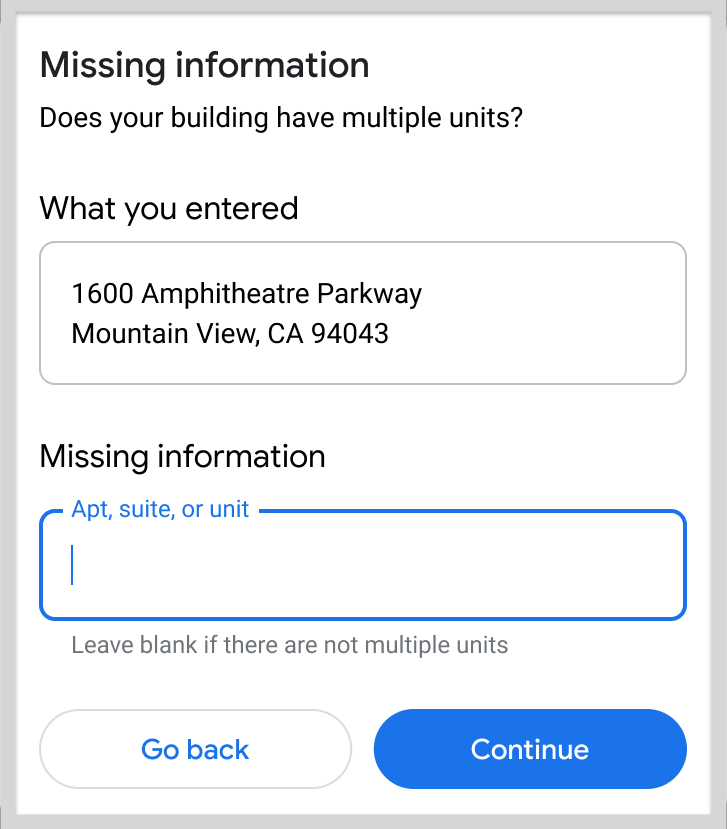
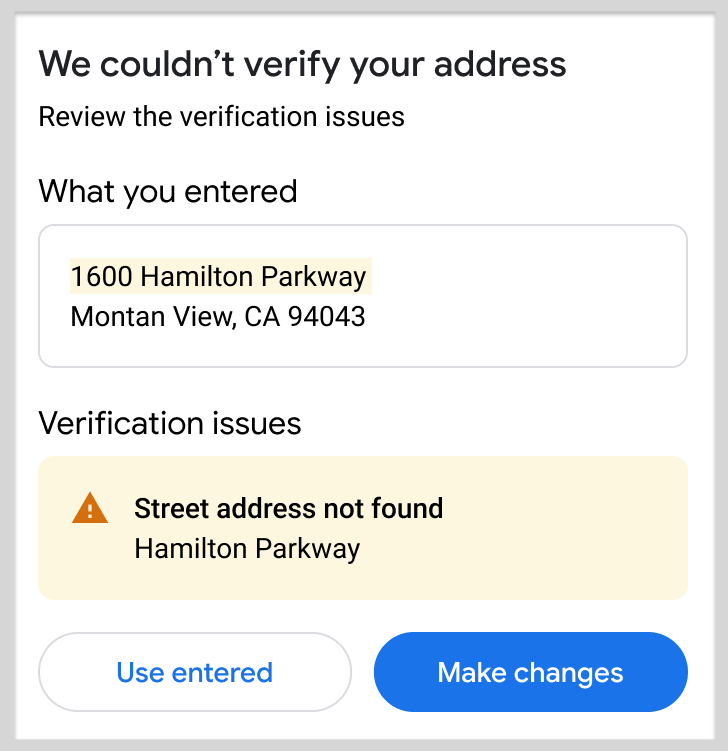
Address Validation API 的運作方式
地址驗證會接受 POST 要求,並以 JSON 主體的形式提供地址。這項服務會將地址拆分成個別元件,然後嘗試執行下列操作:
- 正確:提供元件層級的驗證檢查,包括子場所 (如有)。
- 完成:嘗試推斷缺漏或不正確的地址元件。
- 格式:清理並標準化地址元件的格式。
資源
下表概略說明 Address Validation API 提供的資源,以及傳回的資料。如需具體詳細資料,請參閱地址驗證 API 參考資料。
| 資料資源 | 傳回的資料 |
|---|---|
|
JSON 格式的地址元件。 請參閱「驗證地址」。 |
完整且通過驗證的地址 (如適用)。 每個地址元件的驗證狀態。 地址適用的國家/地區:
請參閱「瞭解驗證回應」。 |
如何使用 Address Validation API
| 1 | 立即試用 | 探索示範 各種正確和不正確的地址表單。 這個範例提供實用的方式,可探索服務傳回的值,以及 JSON 格式的 API 回應。 |
| 2 | 檢查涵蓋範圍 | 請參閱涵蓋範圍詳細資料,瞭解 Address Validation API 支援的國家/地區和區域。 |
| 3 | 做好準備 | 請先設定 Google Cloud 專案,然後按照後續操作說明完成設定。 |
| 4 | 要求驗證地址 | 請先輸入基本地址,然後啟用 CASS (僅適用於美國和波多黎各地址),進一步提升準確度。請參閱「要求地址驗證」。 |
| 5 | 處理回應 | Address Validation API 回應提供兩項屬性,您可分別以不同方式使用。 請參閱「瞭解基本回應」。 |
| 6 | 提高驗證準確度 | 您可以針對 Address Validation API 回應提供意見,協助提升地址準確度。請參閱「處理更新後的地址」。 |
可用的用戶端程式庫
如要查看 Address Validation API 適用的用戶端程式庫清單,請參閱用戶端程式庫。
關於 CASS™
美國郵政署 (USPS®)1 維護編碼準確度支援系統 (CASS™),支援並認證地址驗證服務供應商。經過 CASS Certified™ 認證的服務 (例如 Address Validation API) 能夠填入地址缺少的資訊、標準化地址,並更新地址,確保您取得最新且最準確的地址。
CASS 預設不會啟用,且僅支援「美國」和「波多黎各」地區。如要啟用 CASS,請在驗證要求中將 enableUspsCass 設為 true。詳情請參閱「驗證地址」。
我們使用 USPS 服務時,USPS 會評估人為建立地址的要求。如果 USPS 判定輸入的地址是人為建立,Google 就必須停止為客戶驗證地址,並向 USPS 檢舉客戶的聯絡資訊 (姓名和地址)、相關輸入地址和匯總的使用資料。使用 API 即表示您同意這些服務專屬條款。
後續步驟
- 試用:前往示範頁面
- 查看涵蓋範圍:前往「國家/地區涵蓋範圍詳細資料」
- 嘗試發出第一項驗證要求:前往「傳送地址驗證要求」
- 大量處理地址:請參閱「使用 Address Validation API 大量處理地址」一文。
-
Google 地圖平台是美國郵政署® 的非專屬授權人。下列商標為美國郵政署® 所有,經授權使用:美國郵政署®、CASS™、CASS Certified™。↩


